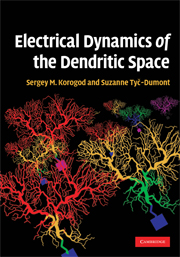Book contents
- Frontmatter
- Contents
- Preface
- 1 Definition of the neuron
- 2 3D geometry of dendritic arborizations
- 3 Basics in bioelectricity
- 4 Cable theory and dendrites
- 5 Voltage transfer over dendrites
- 6 Current transfer over dendrites
- 7 Electrical structure of an artificial dendritic path
- 8 Electrical structure of a bifurcation
- 9 Geography of the dendritic space
- 10 Electrical structures of biological dendrites
- 11 Electrical structure of the whole arborization
- 12 Electrical structures in 3D dendritic space
- 13 Dendritic space as a coder of the temporal output patterns
- 14 Concluding remarks
- Index
Preface
Published online by Cambridge University Press: 03 May 2010
- Frontmatter
- Contents
- Preface
- 1 Definition of the neuron
- 2 3D geometry of dendritic arborizations
- 3 Basics in bioelectricity
- 4 Cable theory and dendrites
- 5 Voltage transfer over dendrites
- 6 Current transfer over dendrites
- 7 Electrical structure of an artificial dendritic path
- 8 Electrical structure of a bifurcation
- 9 Geography of the dendritic space
- 10 Electrical structures of biological dendrites
- 11 Electrical structure of the whole arborization
- 12 Electrical structures in 3D dendritic space
- 13 Dendritic space as a coder of the temporal output patterns
- 14 Concluding remarks
- Index
Summary
Dear Reader,
We invite you to travel in space with us! This will be a very peculiar space: the dendritic space of neurons that is the cosmos for neuroscientists. It is mysterious and practically unexplored like the outer space we glimpse at in the sky. Curiously, we can further extend this analogy: the tools of astronomy can be turned from the sky to the microscope stage to explore shining brain stars, the neurons radiating their dendrites into the surrounding space. This was performed in the pioneering work by Paul Gogan and co-workers using a modified astronomical camera to image the microstructure of the dendritic membrane during the excitation of single live neurons in culture (see references in Chapter 14). The explorers of the dendritic space still have to invent the appropriate spacecrafts and technologies. As in cosmology, experimentation is limited, and mathematical and computer models are the only way of gaining insight into the nature of the dendritic space. The itinerary of our travel relies on these tools.
We start with a brief historical background to the dendritic problem and describe the origin of the structural data used for further morphometric and computer simulation studies of the dendritic arborizations (Chapters 1 and 2). Chapter 3 describes basic bioelectricity with emphasis on space.We show how charge carriers are separated in space and thus electric fields and currents are created across the neuronal membrane. An important generalization is that, despite multiplicity and diversity of channel types, the number of different types of current-voltage relations is restricted to three.
- Type
- Chapter
- Information
- Electrical Dynamics of the Dendritic Space , pp. ix - xiiPublisher: Cambridge University PressPrint publication year: 2009



